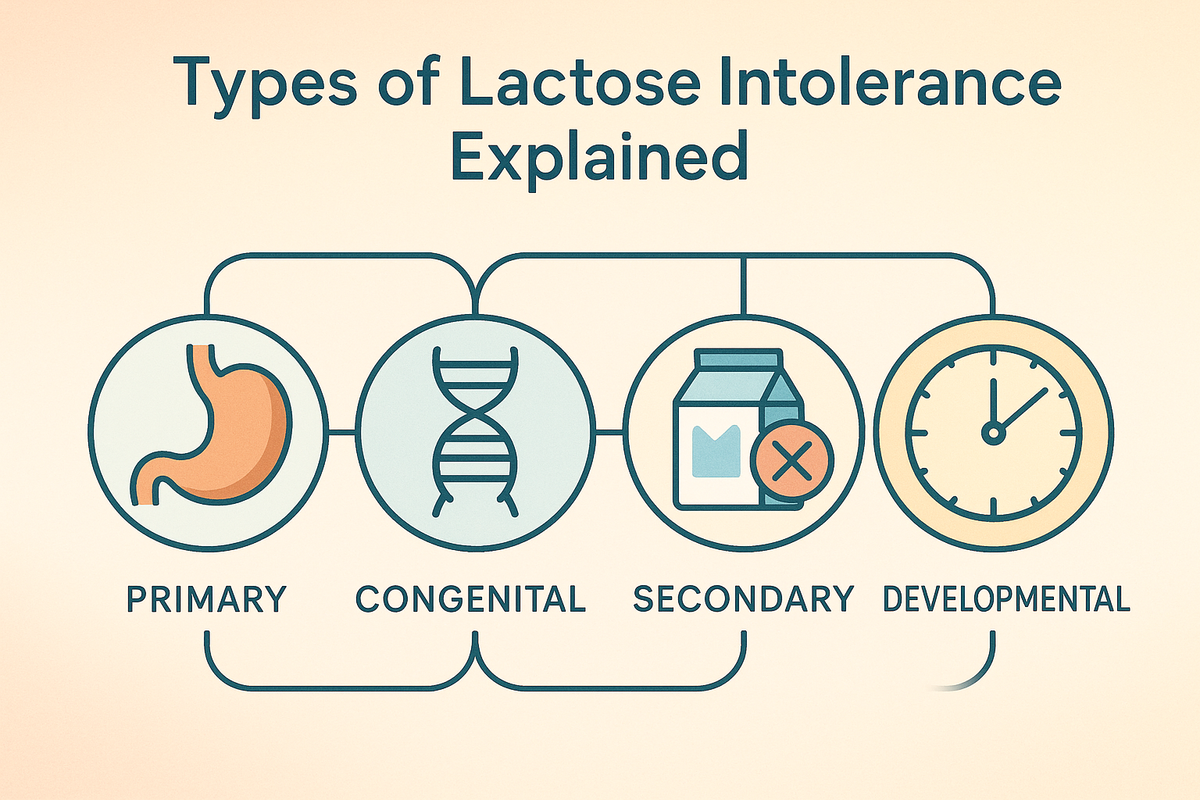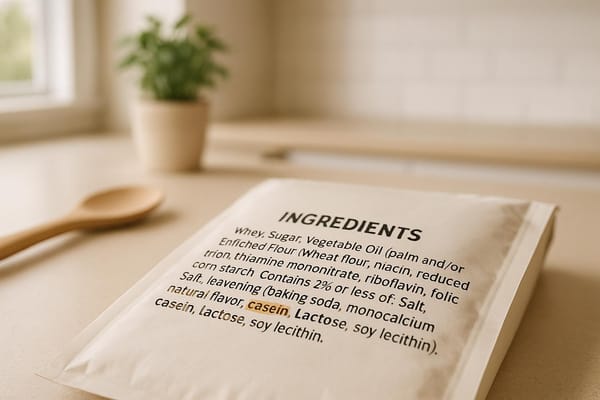Types of Lactose Intolerance Explained
Explore the four types of lactose intolerance, their causes, symptoms, and effective management strategies for a balanced diet.

Lactose intolerance happens when your body can’t digest lactose, a sugar found in milk and dairy products. This occurs due to low levels of lactase, the enzyme responsible for breaking down lactose. Symptoms like bloating, gas, and stomach cramps can appear 30 minutes to 2 hours after eating dairy. But did you know there are four types of lactose intolerance, each with different causes?
Quick Overview of the 4 Types:
- Primary: Most common, develops with age as lactase levels drop.
- Secondary: Caused by illness or injury to the small intestine; often temporary.
- Congenital: Rare, present from birth, and permanent.
- Developmental: Temporary, seen in premature infants due to an immature digestive system.
Key Differences: Primary and congenital types are permanent, while secondary and developmental types can improve with treatment or time. For management, options include diet changes, lactose-free products, and enzyme supplements like lactase pills.
| Type | Reversibility |
|---|---|
| Primary | Permanent |
| Secondary | Often reversible |
| Congenital | Permanent |
| Developmental | Temporary |
Lactose Intolerance - Types, Causes, Pathophysiology, Signs ...
Understanding Lactose Intolerance
Lactose intolerance happens when your body struggles to digest lactose due to low levels of lactase. This digestive issue affects millions across the United States.
How Lactase Works
Lactase is the enzyme that breaks lactose into two simpler sugars: glucose and galactose. These sugars are then absorbed by your body. Without enough lactase, lactose stays undigested, leading to discomfort and other digestive issues.
Common Symptoms
When lactose isn't digested properly, symptoms usually show up within 30 minutes to 2 hours after consuming dairy. These can include:
- Immediate Effects:
- Bloating
- Gas
- Stomach cramps
- Nausea
- Later Effects:
- Diarrhea
- Digestive discomfort
- Feeling overly full
- Decreased appetite
The intensity of these symptoms often depends on how much dairy you consume and how severe your lactase deficiency is.
Milk Allergy vs. Lactose Intolerance
Though often confused, lactose intolerance and milk allergies are not the same. Here's how they differ:
| Characteristic | Lactose Intolerance | Milk Allergy |
|---|---|---|
| Cause | Enzyme deficiency | Immune system reaction |
| Onset of Symptoms | 30 minutes to 2 hours | Usually immediate |
| Affected Systems | Digestive system | Multiple body systems |
| Treatment Approach | Lactase supplements, diet changes | Avoid dairy entirely |
| Risk Level | Uncomfortable, not dangerous | Can be life-threatening |
For those dealing with lactose intolerance, lactase supplements can make it easier to enjoy dairy without triggering symptoms. In the next section, we'll explore how lactase works in more detail and what happens when your body doesn't produce enough of it.
4 Main Types of Lactose Intolerance
Understanding the different types of lactose intolerance helps in managing symptoms more effectively. Below, we break down the four main types, their causes, and how they’re typically addressed.
Primary Lactose Intolerance
This is the most common type and happens when lactase levels naturally decrease with age. It usually starts in adolescence or adulthood and leads to discomfort after consuming dairy products.
Secondary Lactose Intolerance
This type occurs when the small intestine is damaged by illness or injury, temporarily reducing lactase production. It often improves once the underlying issue is treated. Conditions like celiac disease, Crohn's disease, gastroenteritis, or even treatments like chemotherapy and certain medications can trigger it.
Congenital Lactose Intolerance
This rare form is present from birth due to extremely low lactase production. Symptoms appear during an infant’s first feedings, and immediate medical care is essential to ensure proper nutrition.
Developmental Lactose Intolerance
Premature infants may experience this temporary type due to an underdeveloped digestive system. Symptoms typically resolve as the baby grows, with healthcare providers monitoring their diet to ensure they get the nutrients they need.
Side-by-Side Type Comparison
Here’s a breakdown of the four main types of lactose intolerance and how reversible they are. Understanding these differences is key to managing the condition effectively.
Quick Reference Chart
| Lactose Intolerance Type | Reversibility |
|---|---|
| Primary | Permanent |
| Secondary | Often reversible with proper treatment of the underlying issue |
| Congenital | Permanent |
| Developmental | Typically temporary, improving as the digestive system matures |
Primary and congenital lactose intolerance require long-term management, as they are permanent. In contrast, secondary lactose intolerance can often improve once the root cause is addressed. Developmental lactose intolerance, commonly seen in premature infants, usually resolves naturally as their digestive systems develop.
For those dealing with permanent forms, effective management often includes enzyme supplements, such as milktab's lactase pills, which can make digesting dairy much easier. Next, we’ll dive into management strategies involving dietary changes and supplements.
Treatment Options
Managing lactose intolerance effectively depends on the type and severity of your condition. Below are strategies to help you maintain a balanced diet and minimize discomfort.
Diet Changes
The first step in managing lactose intolerance often involves adjusting your diet. Instead of cutting out all dairy, many people find they can tolerate small amounts of lactose when eaten with other foods. Here are some practical options:
| Food Category | Recommended Options | Usage Tips |
|---|---|---|
| Milk Products | Lactose-free milk, almond milk, soy milk | Start with small servings to check your tolerance |
| Cheese | Hard, aged cheeses like cheddar, Swiss, or parmesan | These have lower lactose levels due to aging |
| Yogurt | Greek yogurt, lactose-free yogurt | Offers probiotics that aid digestion |
If modifying your diet isn't enough, enzyme supplements can be a helpful addition.
Lactase Supplements
Lactase supplements make it easier to enjoy dairy without discomfort. For example, milktab's triple-enzyme formula supports digestion with 27,000 FCC units of lactase, 22,000 FCC units of protease, and 1,000 FCC units of lipase per tablet.
"Milktab works great! Most lactose pills don't work for me, super happy I bought these pills." - James
How to use lactase supplements:
- Take them right before eating dairy.
- Stick to the recommended dosage (no more than 2 pills per day).
- Keep them handy, especially when eating out.
While supplements help, it's also important to monitor your overall nutrition.
Nutrition Tracking
When cutting back on dairy, make sure you're still getting key nutrients. Here’s how to meet your daily needs:
| Nutrient | Non-Dairy Sources | Daily Goal |
|---|---|---|
| Calcium | Leafy greens, fortified juices, sardines | 1,000–1,200 mg |
| Vitamin D | Sunlight, fortified cereals, fatty fish | 600–800 IU |
| Protein | Eggs, lean meats, legumes | 46–56 g |
Paying attention to these nutrients ensures your diet remains balanced and supports overall health.
Managing Lactose Intolerance
Understanding the differences between primary, secondary, congenital, and developmental lactose intolerance is key to managing dairy digestion effectively. Identifying your specific type helps you make better decisions about dietary changes and the use of supplements.
For those who struggle with digesting dairy, combining enzyme supplements with tailored dietary adjustments can make a big difference. For example, milktab's triple-enzyme formula is designed to help dairy lovers enjoy their favorite foods without discomfort.
Here’s a practical approach to managing lactose intolerance:
- Identify your specific type: Knowing whether your intolerance is primary or secondary, for instance, can shape your strategy.
- Adjust your diet smartly: Incorporate lactose-free or reduced-lactose options as needed.
- Use enzyme supplements: These can help break down lactose, making dairy easier to digest.
- Monitor your nutrition: Ensure you're getting enough calcium and other nutrients, even with dietary changes.
With these strategies in place, you can confidently manage lactose intolerance while still enjoying a balanced diet that includes your favorite dairy products.
FAQs
How can I find out what type of lactose intolerance I have?
To determine the type of lactose intolerance you have, it’s best to consult a healthcare professional. They can evaluate your symptoms and may recommend tests to identify the specific cause.
If you experience discomfort after consuming dairy, it could be due to insufficient production of lactase, the enzyme needed to break down lactose. In such cases, supplements containing lactase, protease, and lipase may help you digest dairy more comfortably. Always discuss your symptoms and options with a medical expert to ensure the best approach for your needs.
What health conditions can cause secondary lactose intolerance?
Secondary lactose intolerance occurs when an underlying health condition damages the small intestine, reducing its ability to produce lactase, the enzyme needed to digest lactose. Common causes include gastrointestinal infections, celiac disease, Crohn's disease, and irritable bowel syndrome (IBS). These conditions can temporarily or permanently affect the intestinal lining, leading to lactose intolerance.
If you struggle with lactose intolerance, consider solutions like lactase supplements. Products such as milktab are designed to help you enjoy dairy without discomfort by providing a powerful enzyme blend to aid digestion.
How can I manage lactose intolerance while maintaining a balanced diet?
Managing lactose intolerance doesn’t mean you have to miss out on essential nutrients or your favorite dairy-based foods. One effective strategy is using lactase supplements, like milktab, which are specially designed to help break down lactose in dairy products. These supplements make it easier to enjoy dairy without experiencing discomfort.
Additionally, focus on incorporating lactose-free dairy alternatives, fortified plant-based milk, and other calcium-rich foods like leafy greens, almonds, and tofu to maintain a well-rounded diet. By combining these approaches, you can enjoy a healthy and satisfying diet without compromising on nutrition.



